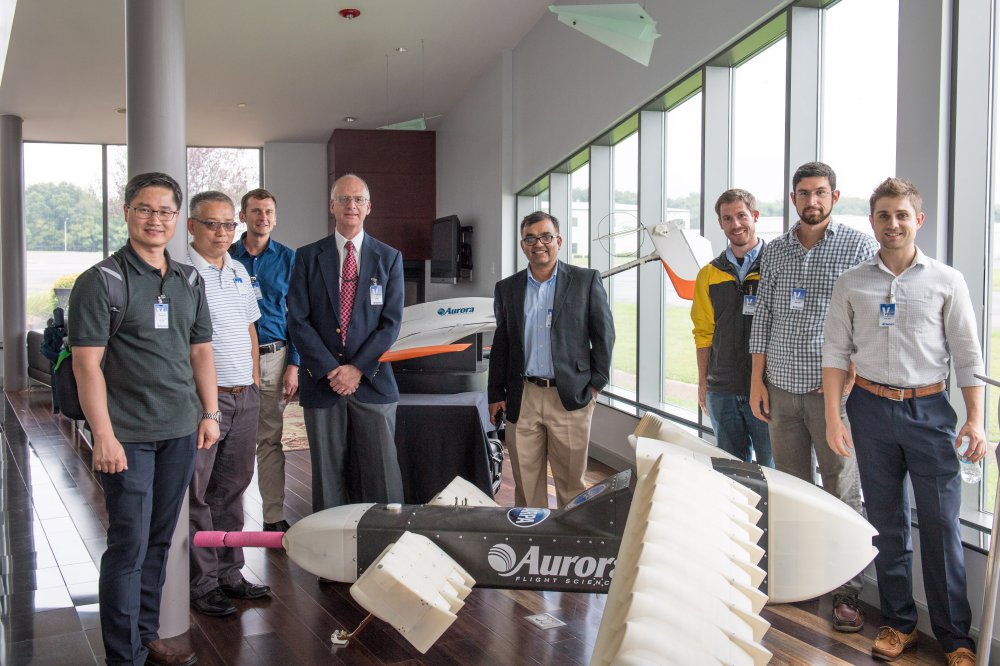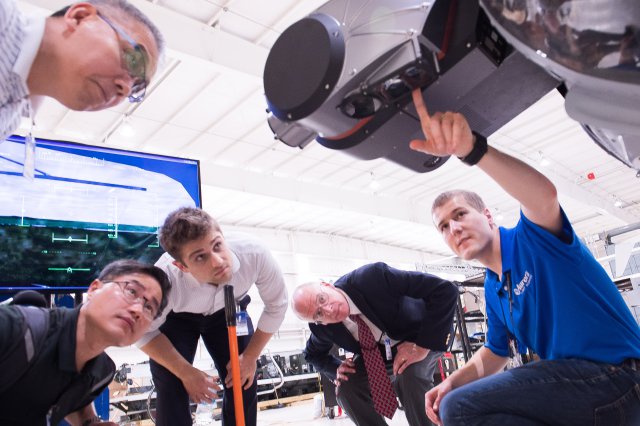At a small airfield near the nation’s capital, an innovative group of engineers is designing and building futuristic aircraft that are catching the attention of Army researchers. The engineering firm, Aurora Flight Sciences, hosted a visit from U.S. Army Research Laboratory aerospace engineers Aug. 15. Earlier this summer, officials from the company visited the Army’s research facilities at Aberdeen Proving Ground, Maryland. Aurora is focused on the development and manufacturing of advanced unmanned systems and aerospace vehicles.
“The things that Aurora knows how to do in aircraft, aerodynamics, aviation propulsion are a really good fit to the Army’s needs in terms of performance, range, payload, those kinds of performance characteristics that the Army needs,” said Dr. John Wissler, director of advanced projects at Aurora.
The Army hopes to achieve high-speed, high-endurance and high-payload capabilities for vertical lift platforms. To achieve those goals, the researchers said they are interested in building a collaborative relationship with Aurora.
The DOD has already invested funding in Aurora’s unique technologies. In 2016, the Defense Advanced Research Projects Agency, or DARPA, awarded Aurora a contract to build a prototype of its LightningStrike aircraft, an unmanned, hybrid propulsion aircraft capable of vertical take-off and landing.
The “unorthodox unmanned aircraft would push the limits of technology to combine plane-like speed and helicopter-like agility into one breakthrough vehicle,” according to the DARPA website.
“It’s going to fundamentally change how we look at rotorcraft,” said Dr. Rajneesh Singh, an acting division chief in the laboratory’s Vehicle Technology Directorate. “In addition to its very innovative, unique design, it has several subsystem technologies that in themselves would lead to huge performance gains even for traditional rotorcraft.”
Singh said Aurora has developed an “out-of-the-box solution to overcome the challenges of vertical flight platforms.”

Army engineers from left to right: Dr. Michael Kweon, Dr. Hao Kang, Dr. Brian Dykas, Dr. Mark Valco, Dr. Rajneesh Singh, James Dotterweich, Michael Avera and Nathan Beals from the U.S. Army Research Laboratory’s Vehicle Technology Directorate, pose with a small-scale prototype from Aurora Flight Systems in Manassas, Virginia, Aug. 15, 2017.
The Army engineers also saw another Aurora project for the U.S. Navy and Marine Corps designed to create an autonomous flight system that can be retrofitted to existing aircraft. The system would give a Marine on the ground “the ability to request a supply delivery via helicopter, which flies to their location with minimal human assistance and autonomously land in an austere, possibly hostile landing zone,” according to Aurora officials.
“I think we’re best known for unmanned aviation, in particular we’re integrating advanced aircraft designs with autonomy to create new kinds of capabilities for the nation,” Wissler said.
“This was sort of a follow-up visit for us to find out a little more about their programs as well as to see some of the projects they have been carrying out.”
Singh said the next step is to explore a CRADA, or cooperative research and development agreement, which is an agreement between a government agency and a private company to work together on R&D.

Army engineers from left to right: Dr. Michael Kweon, Dr. Hao Kang, Dr. Brian Dykas, Dr. Mark Valco, Dr. Rajneesh Singh, James Dotterweich, Michael Avera and Nathan Beals from the U.S. Army Research Laboratory’s Vehicle Technology Directorate, pose with a small-scale prototype from Aurora Flight Systems in Manassas, Virginia, Aug. 15, 2017.
The two organizations hope to move forward on the partnership. After initial discussions, Aurora provided white papers for the Army to review.
“We’ll identify individual areas for each party to contribute and then develop a CRADA mechanism to identify individual responsibilities,” Singh said. “We’ll work together to create a plan to continue advancing the work that has been done with the significant DOD investment.”
The laboratory’s “Open Campus” business model enables researchers to build bridges to industry and academia. It builds the “framework for a global science and technology ecosystem to foster an agile, efficient, and effective research environment supporting the continuous flow of people and ideas to ensure transformative scientific discovery, innovation, and technology transition beneficial to national security,” according to the lab’s Open Campus website.
“Collaboration is really key to make big impacts these days as the challenges are huge [and] resources are limited, and I’m quite positive that a really fruitful partnership will be established and will jointly make advancements in these different technology areas,” Singh said.
Photos: David McNally
—
The U.S. Army Research Laboratory, currently celebrating 25 years of excellence in Army science and technology, is part of the U.S. Army Research, Development and Engineering Command, which has the mission to provide innovative research, development and engineering to produce capabilities for decisive overmatch to the Army against the complexities of the current and future operating environments in support of the Joint Warfighter and the Nation. RDECOM is a major subordinate command of the U.S. Army Materiel Command.
Source: US Army
